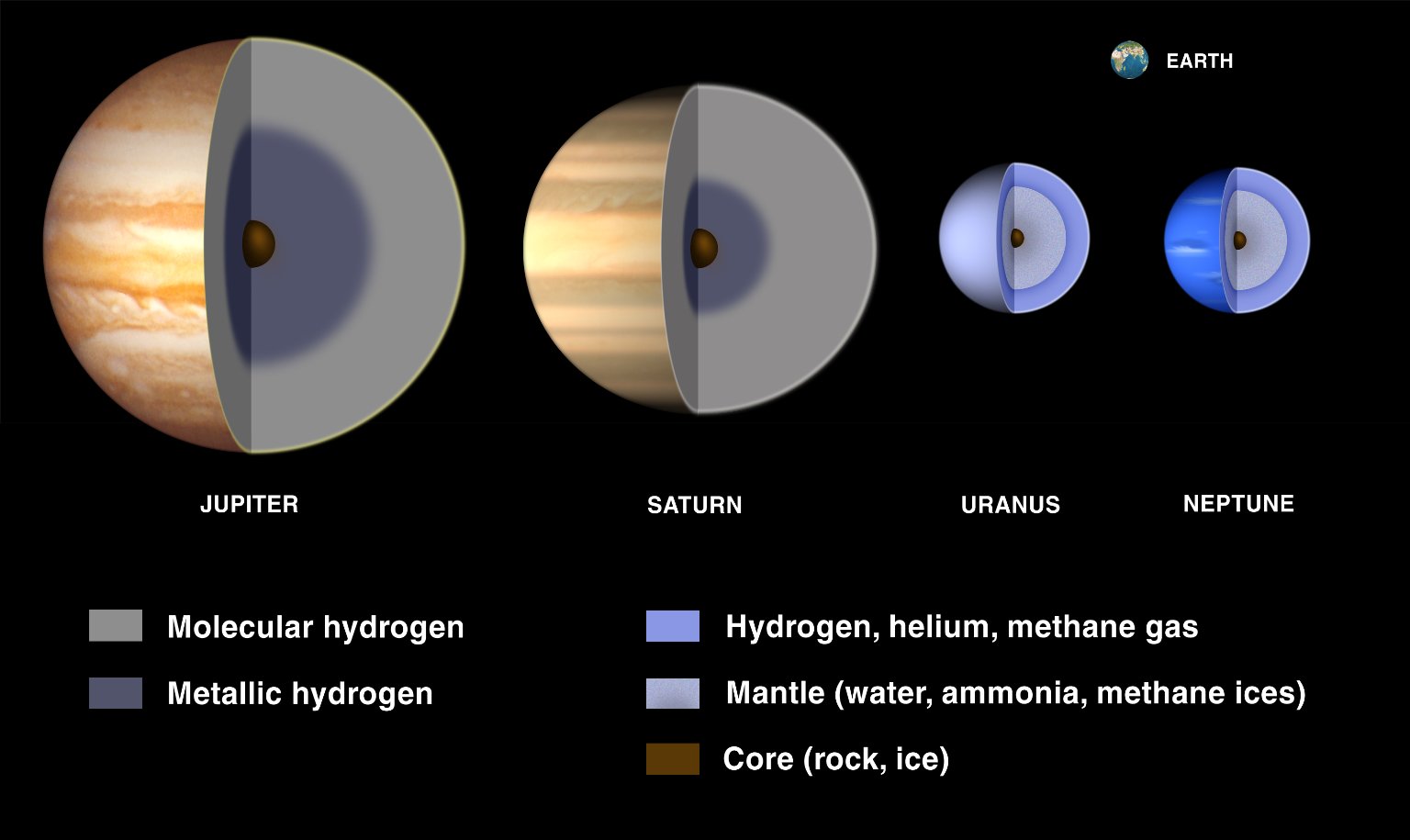
| Interiors of the Jovian Planets(pre-Juno for Jupiter and pre-2021 for Saturn) |
I. Interiors of Jupitera and Saturn
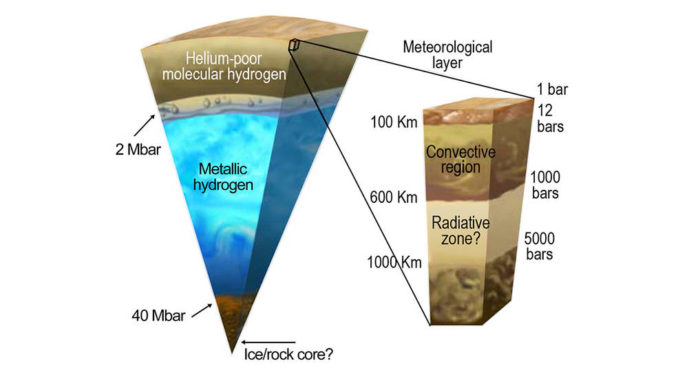

| Interiors of the Jovian Planets(pre-Juno for Jupiter and pre-2021 for Saturn) |

Liquid metallic hydrogen is an odd state of hydrogen. Such a state was first predicted for the high pressures one finds in the interiors of Jupiter (the core has a temperaure of 25,000 C [~45,000 F] and a pressure of 12 million bars -- 12 million times as large as sea level pressure on the Earth and 100,000 times as that on Venus!!) in 1935. Such extreme conditions are not easily produced in Terrestrial laboratories and, in fact, this state for hydrogen was not reproduced in Terrestrial labs until 1990s. This is not the first instance when the extreme conditions found in space, not easily reproduced in earth-labs have led to advances in our understanding of the Universe.
The fact that the hydrogen is liquid means that if you poured it into a cup, it would assume the shape of the cup, but would not spread out throughout the entire volume (as would a gas). The fact that the hydrogen is metallic means that it will conduct electricity. Note that the fact that this layer can flow and can conduct electricity means that Jupiter and Saturn can support large internal electrical currents and should thus show large magnetic fields.
JUNO, the current Jupiter mission, shed
light on this question.
JUNO
results suggest that Jupiter has an enormous fuzzy
core that may be partially dissolved.
JUNO suggests that the core is 10-20 Earth
masses and these materials are spread over around half of Jupiter's radius.
This challenges standard core-accretion models for the formation of
Jupiter-like planets where a compact earth-like core forms that captures
hydrogen and helium gas from the proto-solar nebula.
This led to
the suggestion that an energetic head-on collision between a large
planetary embryo, maybe 10 times the mass of the Earth, and
the proto-Jupiter took place. In the collision, the impacting object
could have shattered
and combined with the young Jupiter's core. The combined cores were
then distributed and mixed over the inner part of the early Jupiter's interior,
perhaps as far out as 50 % of Jupiter.
How did Juno figure this out?
Juno measured the gravitational field of
Jupiter. Every 53 days JUNO
dives in toward Jupiter as it orbits the planet. During these close
encounters, JUNO makes sensitive measurements of the
gravitational field of Jupiter allowing it to probe its interior.
In 1997
measurements of the gravity around Jupiter made by
Galileo indicated that
Jupiter had a rocky core
which contained 14 to 42 Earth masses. It, however, was possible
that the core was smaller and perhaps not there at all.

What lurks at Saturn's core?
The rings of Saturn were discovered in the early 1600s by Galileo. They appear to be solid as viewed from Earth but close looks reveal that they are made up of small chunks (centimeters to tens of meters) of rock and ice (based on their reflectivity); each particle orbits Saturn obeying a version of Kepler's Laws of planetary motion.

The rings are exceedingly thin, as viewed from spacecraft the inner regions of the ring (the C ring) are less than 10 m in thickness and the main portion of the ring (the A ring) is 50 m in thickness. The rings are about than 250,000 km in diameter! The rings are thin. A standard sheet of copy paper (8.5 in x 11 in = 216 mm x 279 mm) has thickness 0.1 mm or about 0.04 % of the length of the paper. The rings have thickess 0.00002 % of the diameter of the rings. They are relatively much thinner than a sheet of paper. Viewed edge-on the rings almost disappear from view from the Earth as seen during ring-plane passages.
The radius of Saturn is ~60,000 km and so, roughly speaking, the ring system of Saturn sits within about 1 planetary radius of the surface of the planet. This is a general property for ring systems because of something known as the Roche limit. The Roche limit arises because of tidal effects. As a moon approaches Saturn, tidal effects become larger. Within the Roche limit tidal effects can tear apart the moon. The Roche limit is roughly twice the radius of the planet for all of the Jovian planets. All of the ring systems for the Jovian planets do sit within their Roche limits.
There are several distinct regions in Saturn's ring system:
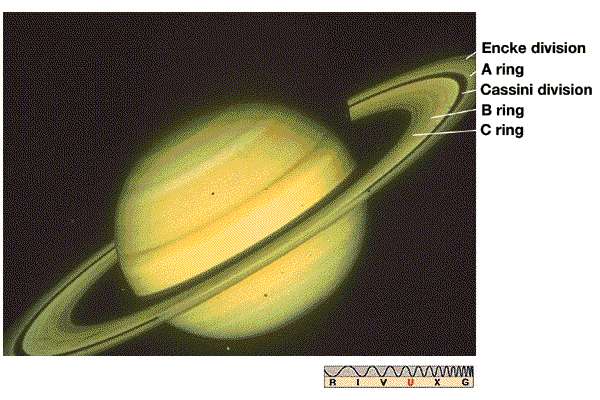
The large gap separating the main rings (the A ring and the B ring), is known as the Cassini division (see below). There are fainter rings inside of the B ring known as the C and D rings. Embedded in the A ring is the gap known as the Encke division (see below). These large gaps probably arise because of resonances. For example, a particle moving in the Cassini division has an orbital period 1/2 that of a moon Mimas which leads to a 2:1 resonance.

Outside the A ring sits the narrow F ring. The F ring is interesting in its narrowness and its nonregular shape (it appears braided). The narrowness of the F ring is thought to arise because of the effects of shepherd moons, Pandora and Prometheus. (Note that the Encke division is thought be opened by the effects of the shepherd moon Pan embedded in the A ring.)
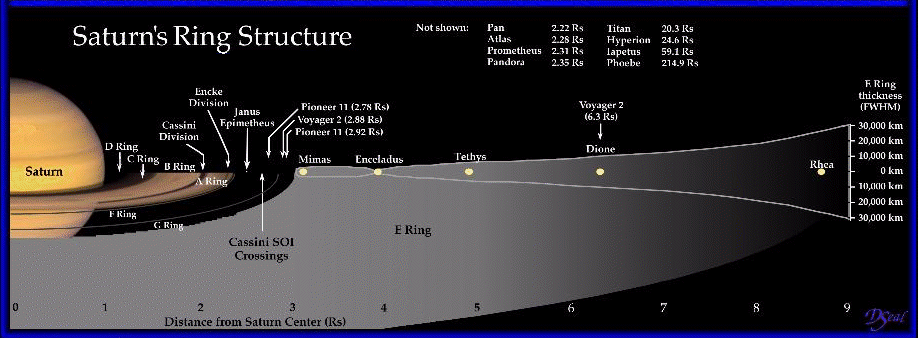
The rings are even more complicated than shown above, much finer structure exists,

much of which is hard to understand.
The great complexity and other things apparently going on in the rings suggests that they are fairly young, less than 100 million years or so perhaps as little as 10 to 50 million years old. Observations made by Cassini made during its Grand Finale, suggests that the rings of Saturn are not debris left over from the formation of the planet. Rather the rings are likely caused by the breakup of a moon or are continuously replenished by pieces chipped off of moons. The exact answer is not clear. Furthermore, the young age is still debated. Cassini observed dust in the rings. Cassini found that the amount of dust was consistent with the dust having been deposited over the last 100 million years. If the rings were 4.6 billion years old, there would have been much more dust. Until we can age date the rocks in the rings, we cannot definitively say how old they are.
Cassini looked at occultations of stars passing behind the rings of Saturn (watching transits of the ring particles in front of distant stars!), observations were carried out in the last days of Cassini's mission, the Grand Finale, the ring plane-crossing phase. The observations took place a little before Cassini's final destructive dive into the atmosphere of Saturn on September 15th, 2017. Cassini detected very low frequency spiral waves crossing the inner C ring. Although many things affect the rings overall, it is thought that Saturn itself disturbs the C ring exciting the ripples detected by Cassini.
Astronomers surmised that the surface of Saturn was pulsating a meter or so every few hours, exerting tidal forces that rippled through the ring system. See here for further pictures from Cassini's Grand Finale.
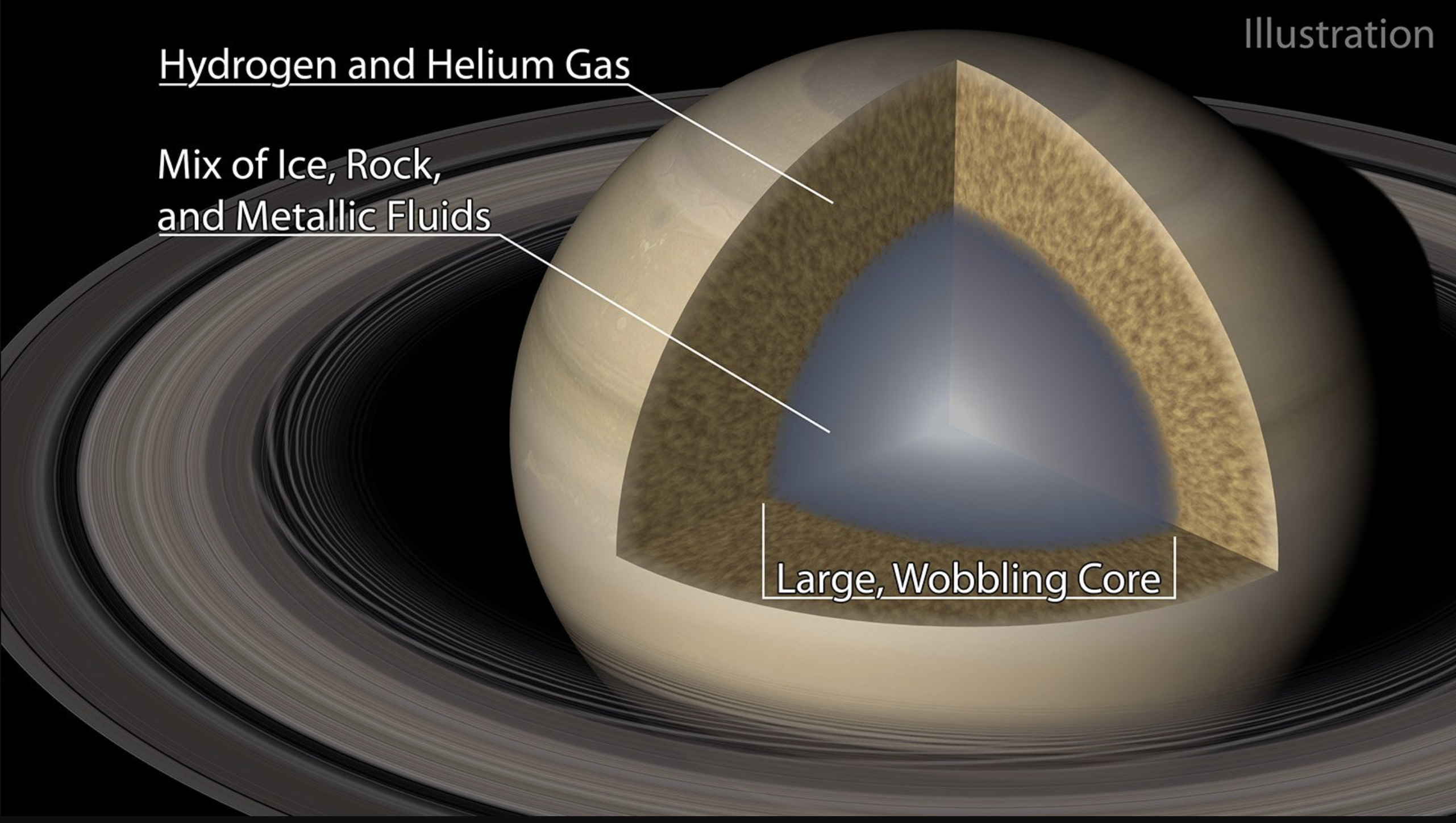
The oscillation says something about what's going on inside Saturn's interior.
 |
 |
The impact produced huge seismic disturbances which were observed to propogate around Jupiter at speeds of 450 kilometers per second; the waves propogated through the troposphere or the stratosphere and did not pass through the deep interior of Jupiter.
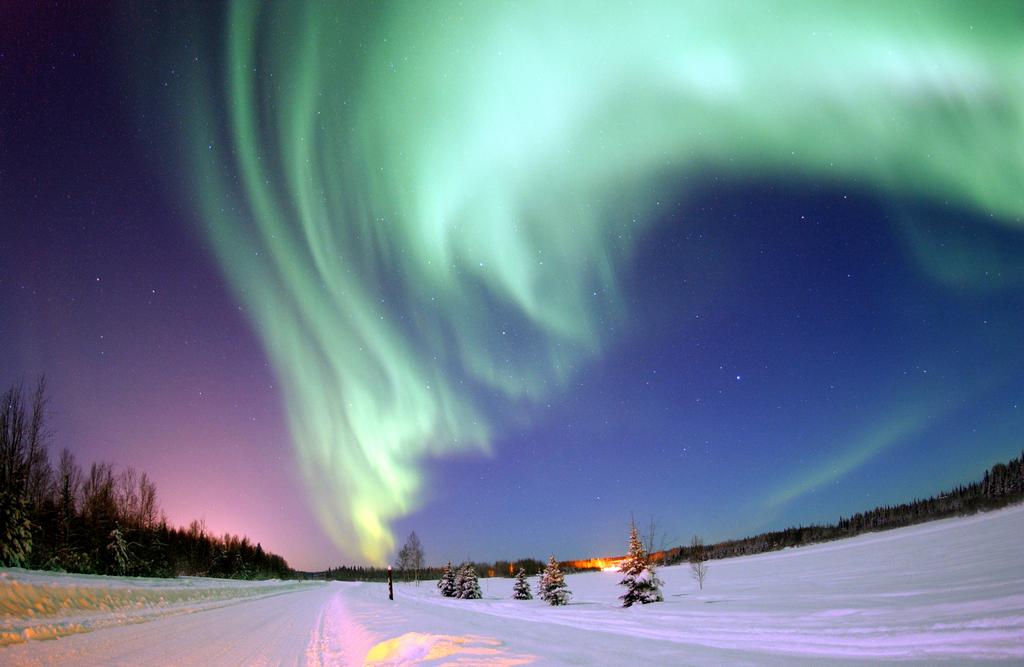 |
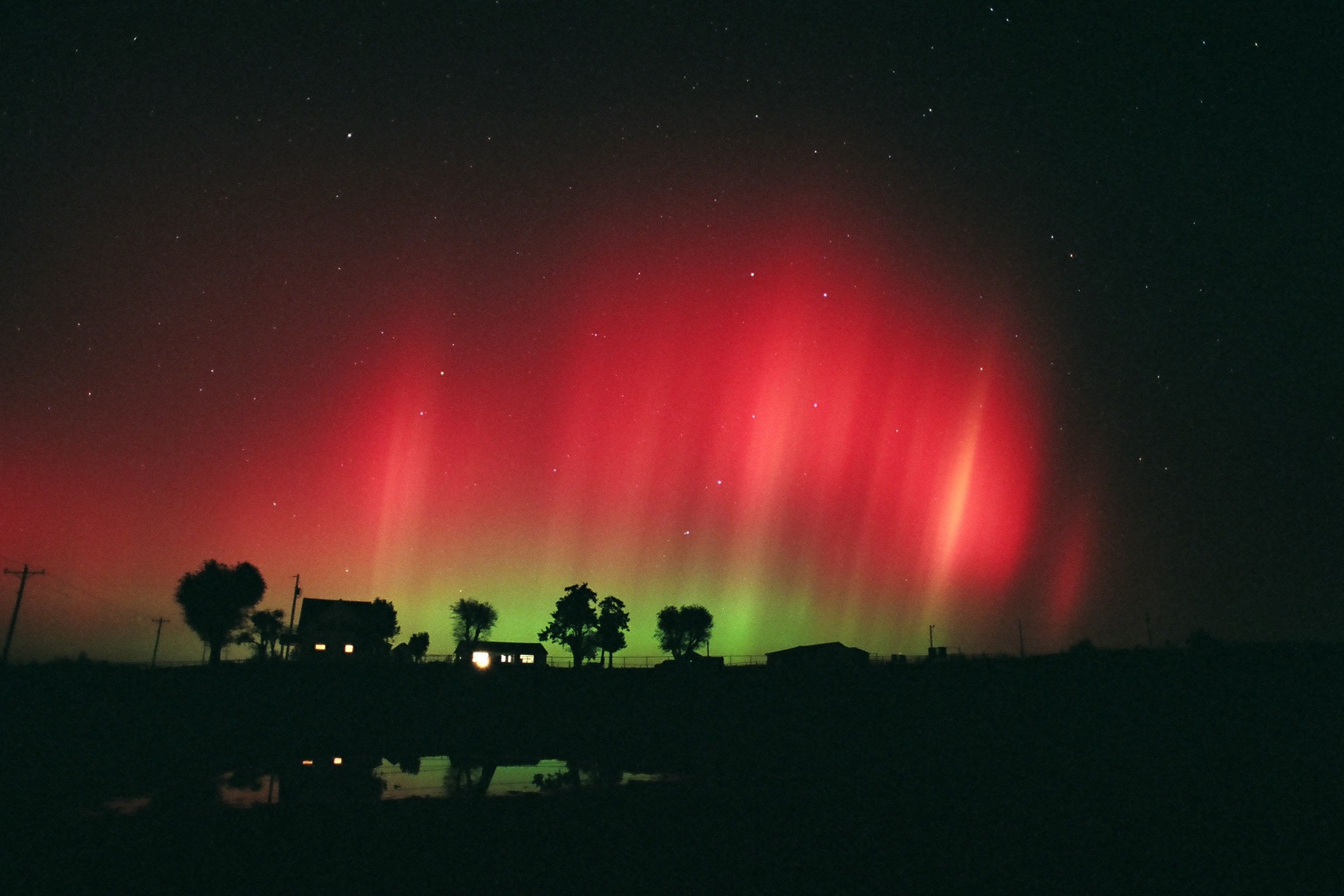 |
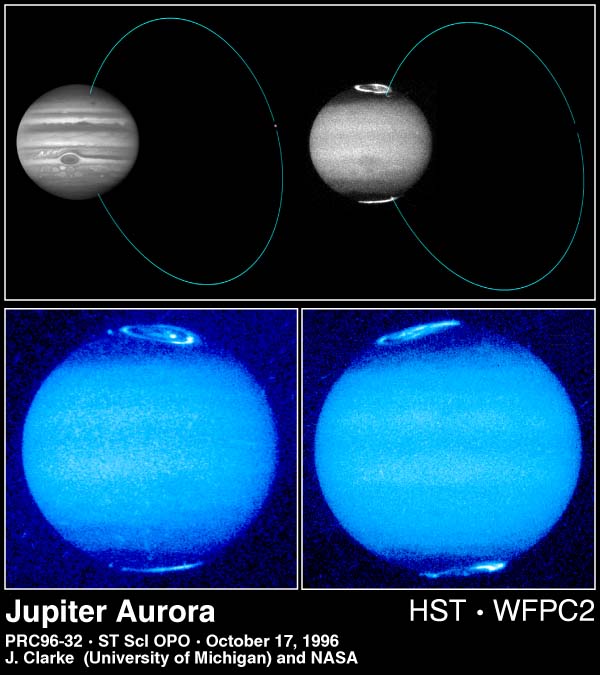 |
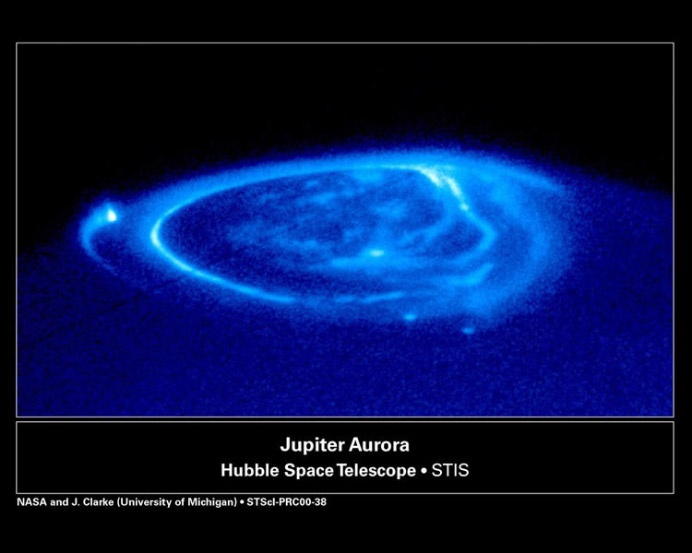
| Jupiter shows strong aurora (as does the Earth, upper left and center pictures are of the Aurora Borealis). Aurora on Earth are produced by charged, high energy particles striking atomic and molecular oxygen and nitrogen. Excited oxygen glows in yellowish and greenish hues with a brownish-red component at the limit of human eye perception (this is rarely seen); excited nitrogen glows in reddish shades and ionized nitrogen glows with a bluish tint. Aurora on Jupiter are produced by charged particles (such as electrons) spiraling in the magnetic field of Jupiter. Electrons precipitate into the atmosphere of Jupiter where the ionize and excite hydrogen molecules leading to UV radiation. |
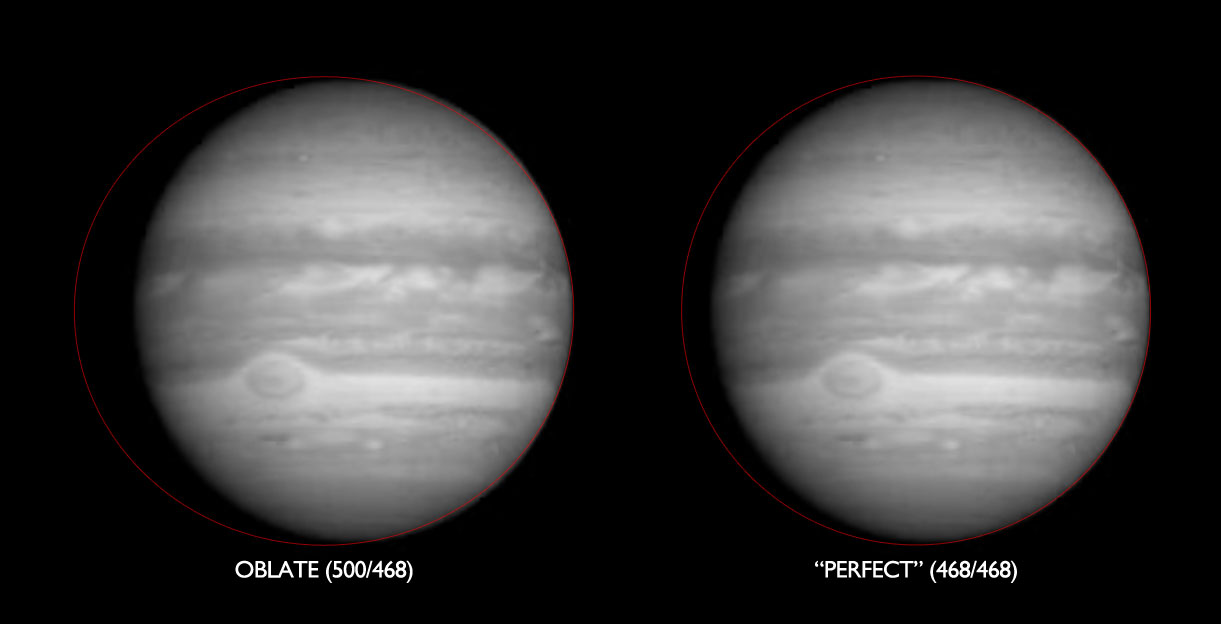
Star:
Credits: NASA, https://www.nasa.gov/audience/forstudents/k-4/dictionary/Star.html
An interesting sidelight is that Jupiter and Saturn radiate
more energy than they
receive from the Sun.
Jupiter radiates 1.5-2 times as much energy as it receives from the Sun
Saturn radiates 2-3 times as much energy as it receives from the Sun
Are Jupiter and Saturn therefore considered to be stars? Where does this excess heat come from?
Saturn cools faster than Jupiter and so, after ~2.6 billion years, atmosphere gets cool enough for helium to condense and rain out.

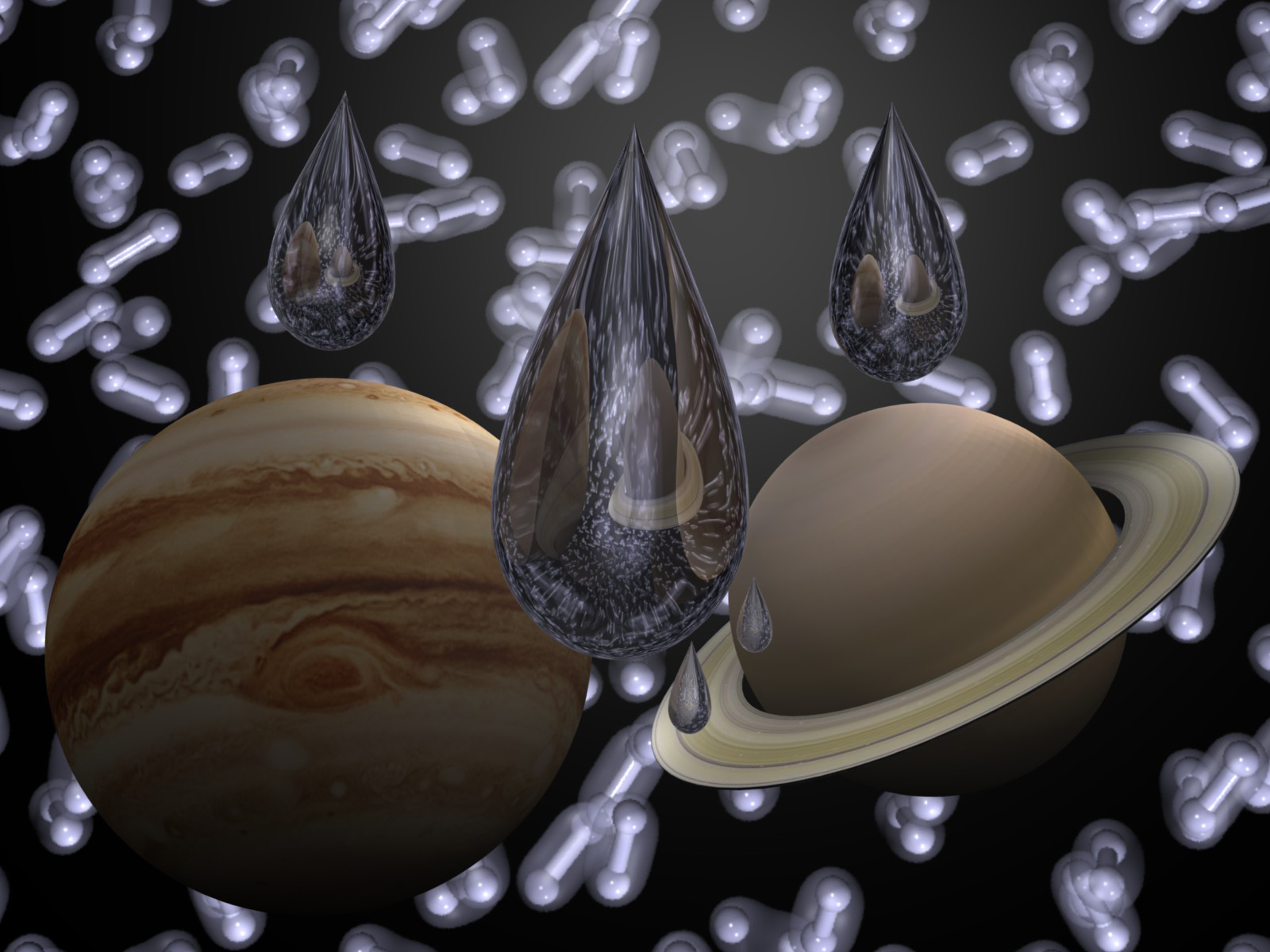
| As the helium rains through the planet it gains energy because gravity pulls it inward. As it moves through the liquid H2, friction slows the drops down and heats up the hydrogen. This extra heat is then radiated by Saturn.A natural prediction of this model is that the atmosphere of Saturn should contain less helium than does the atmosphere of Jupiter. Is this true? Yes, the atmosphere of Jupiter is more than 10 % helium while the atmosphere of Saturn is 6 % helium. Amazing! A prediction is that in the future, Jupiter should show the same behavior. |